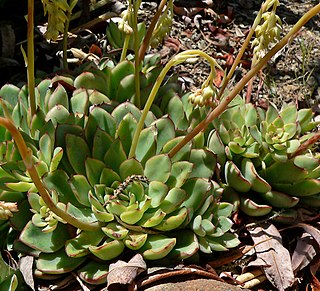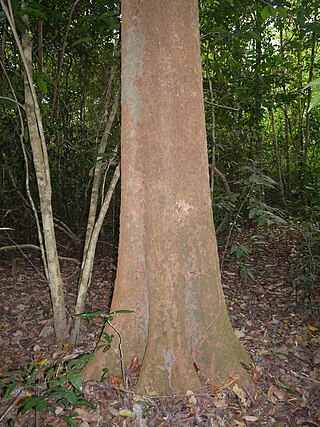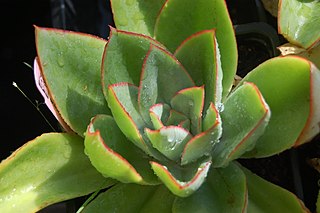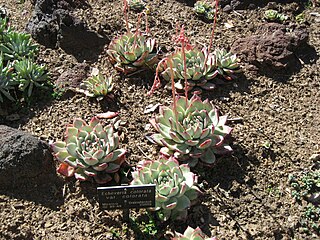
Echeveria is a large genus of flowering plants in the family Crassulaceae, native to semi-desert areas of Central America, Mexico and northwestern South America.

Echeveria elegans, the Mexican snow ball, God's Throne, Mexican gem or white Mexican rose is a species of flowering plant in the family Crassulaceae, native to semi-desert habitats in Mexico.

Echeveria agavoides, or 'lipstick' echeveria, is a species of succulent flowering plant of the stonecrop (sedum) family Crassulaceae, native to the rocky canyons and arid hillsides of Central Mexico. It is primarily known from the states of Aguascalientes, Durango, Guanajuato, Hidalgo, Jalisco, Querétaro, San Luis Potosí and Zacatecas, though it has been sighted as far north as Coahuila and as far south as Oaxaca.

Echeveria runyonii is a species of flowering plant in the family Crassulaceae, that is native to the state of Tamaulipas in Mexico. Several cultivars have been described and cultivated.

Echeveria derenbergii, the painted-lady, is a species of flowering plant in the family Crassulaceae, endemic to Mexico.

Echeveria pulidonis is a species of flowering plant in the family Crassulaceae, native to central Mexico, more specifically, Puebla and Veracruz.

Parinari anamensis is a dicotyledonous plant species that was described by Henry Fletcher Hance from southern Vietnam. It has been called Annamese burada and is now placed in the family Chrysobalanaceae,. No subspecies are listed in the Catalogue of Life.
Walsura robusta is a tree species described by William Roxburgh; it is included in the family Meliaceae. No subspecies are listed in the Catalogue of Life. In Vietnamese its name is lòng tong.

Suregada multiflora, sometimes called the "false lime tree", is a species in the family Euphorbiaceae. The Catalogue of Life lists no subspecies. It is found in tropical Asia: names include kén or mân mây in Viet Nam.
Garcinia celebica is an accepted name of a tree species in the family Clusiaceae. The Catalogue of Life lists no subspecies.

Dipterocarpus baudii is the accepted name of a tropical forest tree species in the family Dipterocarpaceae; there are no known subspecies.

Echeveria multicaulis is a species of plant native to Mexico. It is a member of the genus Echeveria.
Dalbergia parviflora is a species of liana found in South East Asia. Its name is kayu laka in Malay and Indonesian, from which the word lakawood, the heartwood of the plant used for incense, is derived.

Echeveria subrigida is a species of succulent plant native to Mexico. It was first formally described in 1903 by Benjamin Lincoln Robinson and Henry Eliason Seaton. Its basionym is Cotyledon subrigida.

Echeveria colorata, is a species of flowering plant in the family Crassulaceae, endemic to Mexico.

Stylidium piliferum is a species of dicotyledonous plant from the genus Stylidium. It is found in Western Australia.

Silene sorensenis, the three-flowered campion or Sorensen's catchfly, is a species of plant in the family Caryophyllaceae. It is found in the tundra of the Canadian Arctic Archipelago, the Northern Russian Far East and Greenland.

Bouea is an Asian genus of fruiting trees in the family Anacardiaceae. Species can be found in southern China, Indo-China and Malesia.

Veronica bellidioides is a flowering plant species in the genus Veronica of the family Plantaginaceae. It is native to Europe. This species was described by Carl von Linné.
Saxifraga consanguinea is a flowering plant species in the genus Saxifraga of the family Saxifragaceae.
















